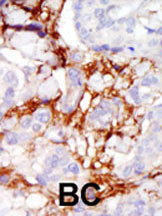PAK3 Antibody (Center K218)
Purified Rabbit Polyclonal Antibody (Pab)
- 产品详情
- 实验流程
- 背景知识
Application
| WB, IHC-P, E |
|---|---|
| Primary Accession | O75914 |
| Reactivity | Human |
| Host | Rabbit |
| Clonality | Polyclonal |
| Isotype | Rabbit IgG |
| Calculated MW | 62310 Da |
| Antigen Region | 218-247 aa |
| Gene ID | 5063 |
|---|---|
| Other Names | Serine/threonine-protein kinase PAK 3, Beta-PAK, Oligophrenin-3, p21-activated kinase 3, PAK-3, PAK3, OPHN3 |
| Target/Specificity | This PAK3 antibody is generated from rabbits immunized with a KLH conjugated synthetic peptide between 218-247 amino acids from the Central region of human PAK3. |
| Dilution | WB~~1:1000 IHC-P~~1:100~500 E~~Use at an assay dependent concentration. |
| Format | Purified polyclonal antibody supplied in PBS with 0.09% (W/V) sodium azide. This antibody is prepared by Saturated Ammonium Sulfate (SAS) precipitation followed by dialysis against PBS. |
| Storage | Maintain refrigerated at 2-8°C for up to 2 weeks. For long term storage store at -20°C in small aliquots to prevent freeze-thaw cycles. |
| Precautions | PAK3 Antibody (Center K218) is for research use only and not for use in diagnostic or therapeutic procedures. |
| Name | PAK3 |
|---|---|
| Synonyms | OPHN3 |
| Function | Serine/threonine protein kinase that plays a role in a variety of different signaling pathways including cytoskeleton regulation, cell migration, or cell cycle regulation. Plays a role in dendrite spine morphogenesis as well as synapse formation and plasticity. Acts as a downstream effector of the small GTPases CDC42 and RAC1. Activation by the binding of active CDC42 and RAC1 results in a conformational change and a subsequent autophosphorylation on several serine and/or threonine residues. Phosphorylates MAPK4 and MAPK6 and activates the downstream target MAPKAPK5, a regulator of F-actin polymerization and cell migration. Additionally, phosphorylates TNNI3/troponin I to modulate calcium sensitivity and relaxation kinetics of thin myofilaments. May also be involved in early neuronal development. In hippocampal neurons, necessary for the formation of dendritic spines and excitatory synapses; this function is dependent on kinase activity and may be exerted by the regulation of actomyosin contractility through the phosphorylation of myosin II regulatory light chain (MLC) (By similarity). |
| Cellular Location | Cytoplasm. |
| Tissue Location | Restricted to the nervous system. Highly expressed in postmitotic neurons of the developing and postnatal cerebral cortex and hippocampus. |
For Research Use Only. Not For Use In Diagnostic Procedures.
Provided below are standard protocols that you may find useful for product applications.
BACKGROUND
PAK3, a member of the STE20 subfamily of Ser/Thr protein kinases, acts on a variety of targets. PAK3 interacts tightly with GTP-bound but not GDP-bound CDC42/p21 and RAC1. It shows highly specific binding to the SH3 domains of phospholipase C-gamma and of adapter protein NCK. This protein is highly expressed in postmitotic neurons of the developing and postnatal cerebral cortex and hippocampus. PAK3 is autophosphorylated when activated by CDC42/p21. Defects in PAK3 are the cause of non-specific X-linked nonsyndromic mental retardation type 30 (MRX30). The protein structure contains 1 CRIB domain.
REFERENCES
Kitano, T., et al., Mol. Biol. Evol. 20(8):1281-1289 (2003).
Allen, K.M., et al., Nat. Genet. 20(1):25-30 (1998).
终于等到您。ABCEPTA(百远生物)抗体产品。
点击下方“我要评价 ”按钮提交您的反馈信息,您的反馈和评价是我们最宝贵的财富之一,
我们将在1-3个工作日内处理您的反馈信息。
如有疑问,联系:0512-88856768 tech-china@abcepta.com.























 癌症的基本特征包括细胞增殖、血管生成、迁移、凋亡逃避机制和细胞永生等。找到癌症发生过程中这些通路的关键标记物和对应的抗体用于检测至关重要。
癌症的基本特征包括细胞增殖、血管生成、迁移、凋亡逃避机制和细胞永生等。找到癌症发生过程中这些通路的关键标记物和对应的抗体用于检测至关重要。 为您推荐一个泛素化位点预测神器——泛素化分析工具,可以为您的蛋白的泛素化位点作出预测和评分。
为您推荐一个泛素化位点预测神器——泛素化分析工具,可以为您的蛋白的泛素化位点作出预测和评分。 细胞自噬受体图形绘图工具为你的蛋白的细胞受体结合位点作出预测和评分,识别结合到自噬通路中的蛋白是非常重要的,便于让我们理解自噬在正常生理、病理过程中的作用,如发育、细胞分化、神经退化性疾病、压力条件下、感染和癌症。
细胞自噬受体图形绘图工具为你的蛋白的细胞受体结合位点作出预测和评分,识别结合到自噬通路中的蛋白是非常重要的,便于让我们理解自噬在正常生理、病理过程中的作用,如发育、细胞分化、神经退化性疾病、压力条件下、感染和癌症。







